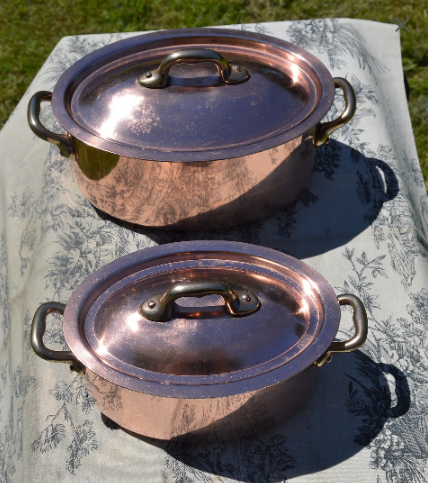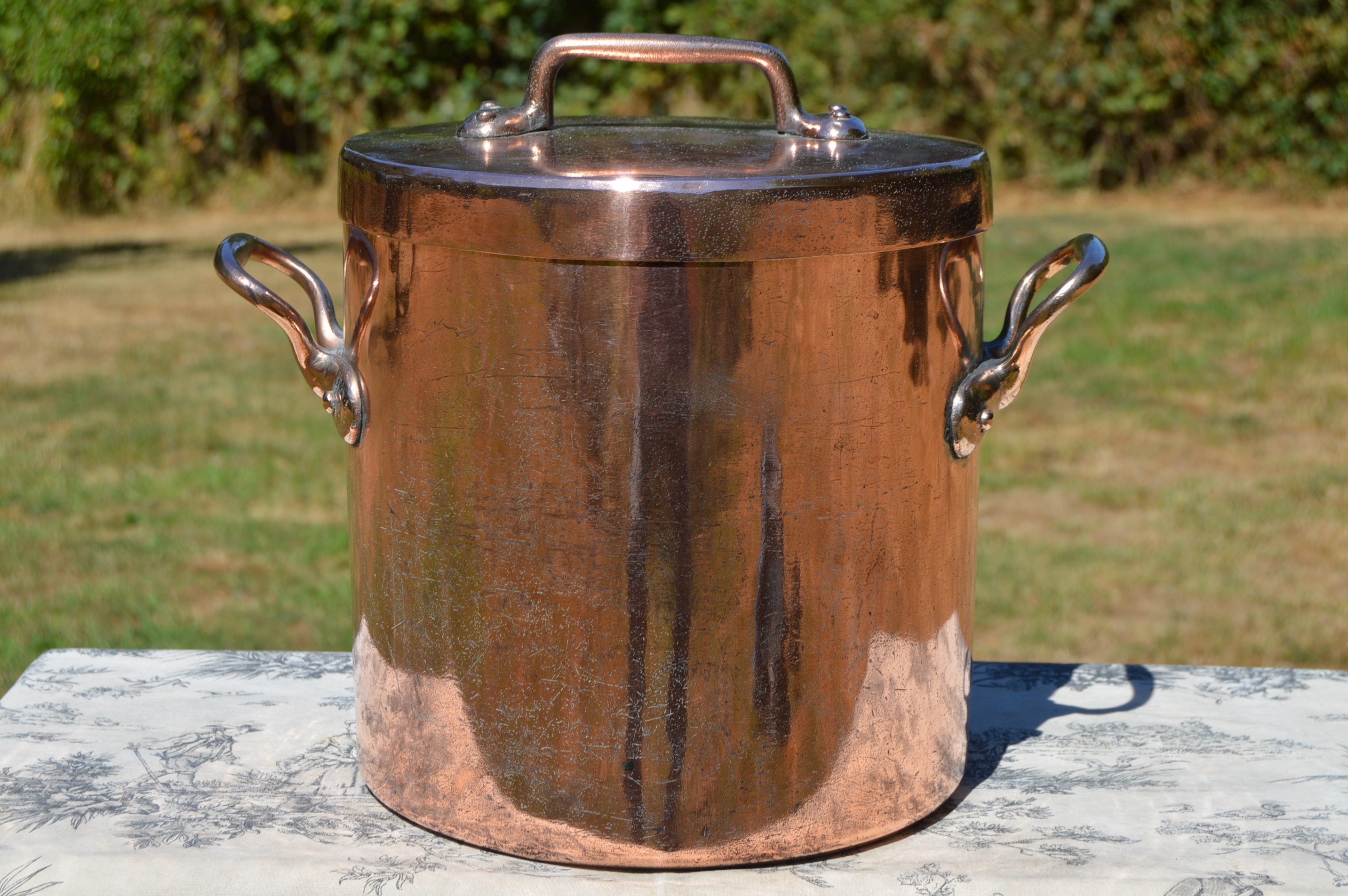Part Two
Marmites, 'Faitouts', Bassine a ragoût, Daubiere ovale , Braisieres rectangulaires, Braisieres ovales, Faitout conique, Marmites droits, Poissonieres, Turbotieres, Boites a aperges, Jambonneau, Saumonnier, Marmites a pomme de terre, Marmite pomme vapeur, Faitout cylindrique, Chaudrons a legumes, Marmite a bouillon, Pomme Anna, Marmite a couscous this is not an exhaustive list!
There are many French copper pans and pots that have different uses and different styles and measurements. These styles have evolved over time have become more specialized and in some cases are just for one type of ingredient or one recipe. All French copper pans have their ancestor as the cauldron over an open fire, on possibly a tripod or attached feet but more often in the fire itself. Cooking was a hot dirty job, with spitting foods, a hot environment that was difficult to control and resulted in poorly cooked food.

In French gastronomy, there are three main areas of cooking based on an economic and cultural hierarchy. The regional cookery of the peasants and the urban poor - lots of one pot stews and cooked over an open fire or range, the cuisine bourgeoise - middle class cooking mainly done by women in the home and haute cuisine expensive and sometimes complicated French restaurant cooking. Marie-Antoine Carême the founder of haute cuisine and Auguste Escoffier (amongst others) distilled all that had come before in French Cooking, reorganised kitchens and their workers - notably the la brigade de cuisine and put it into practice. Auguste Escoffier in particular wrote books on how to cook designed for large kitchens as well as individual homes. Who instead of just listing recipes and ingredients they described the cooking techniques, the recipes and of course the perfect pots to do it in. This type of cuisine française 'educational recipe book' has been developed and enhanced over many years. Even up to the present day we defer to modern Chefs such as Keith Floyd in Floyd on France (1987) in the UK and Julia Childs who instigated a whole new movement in French Cooking in the US in the 1960s with her book Mastering the Art of French Cooking (1961, 1970). These modern cooks were looking back, they were re-educating us cookbook by cookbook and reinvigorating our need to cook properly, with conviction. Ultimately to produce food with a verifiable heritage, in a tried and tested way developed with experience and expertise, with copper pots that have stood the test of time, perfectly.
Cooking styles, recipes, ingredients and cooking pots have developed over time - here are some examples of French cooking pots that have adapted and survived very well in modern copper kitchens.
It is important to note that the design ratio of the size of the pans go to the specific use of the pan.
Boites

Boites are literally boxes made from copper and are designed for various tasks. These can have inserts and separate linings - especially if they are used for boiling water. They can be for cooking asparagus, large hams, poaching anything and used for storing dry goods like flour.
Bassine a Ragoût

Not to be confused with plat à sauter deux poignées, dit 'rondeau' or a double handled saute, this bassine a ragoût is essentially a stew pot or a casserole in the UK and a Dutch Oven or Stew Pot in the US. It is shorter than a Marmite and is ideal for browning meat then cooking slowly on either a burner or in an oven. Not too tall, easier to move and clean. Very versatile and useful.

Braisières


This is a simple pan with a simple job, this design has been used since the early 1700's (and before in different guises). It makes great confit, a sort of single ingredient stew that has the rendered and added fat left in it to form a layer on top of the meat, it then can be kept for many months - 'Confit du Canard'. We buy it in tins these days - but this will make your own.

Of course, you can cook any meat, fish or vegetable in this, put it on your woodburner and leave it, the tight fitting lid will keep all the moisture and flavour in, this is a great useful, beautiful, special and above all a great useful pan.
This is the best of both worlds for the copper enthusiasts who want to see the age but still use the heirloom - copper history in action.
This fabulous pan can be used today as it was when it was new, you can start making new memories with this, sitting making a stock or stew on your cooker, hob, range, wood burner or fire, just doing its job, needed as necessary. These types of Braisières can be called Daubières, Chaponnières or even Poupetonnières (the nearest to this is Paté or meat paste!) they are for cooking a l' étouffé or sealed without air - hermetically sealed.
Cocottes ronde ou ovale
These are generally smaller in size than Marmites or Bassines a ragoût they are used to cook whole chickens or smaller poultry. They can be used for side dishes and or single mains, for pies and puddings. A follow on from the Tourtière perhaps?


Faitout

Faitout is a term that is used extensively in the modern copper vocabulary, it is usually used to describe a big stock pot - marmite a droit or any big pot with straight sides. This term came about in the mid 19th century to describe a big pot that literally 'did it all' fait-tout in a domestic setting, it always had two strong side handles and a good solid lid.
Marmites

This name covers many different styles of pot but essentially they have a tall body with the diameter about the same, always with a lid and almost always with two handles to the side. They stared out life in the mid 1500s with legs to place in a fire or cheminée. Later they developed into flat bottomed pots - sometimes referred to as faitouts - as these pots were used for making soups, stews and broths, can boil vegetables, poach meats and fish. Your marmite a droite is a pot that can do it all.

Marmite Couvercle Emboitant - Stock Pot with Snug Cover Lid or Covering Lid
This is a tall pot, it has straight sides and a snug covering lid. This is ideal for using as a stock pot, the high sides and the lid ensure that moisture is kept in the pot. Ensuring that your broth, stock or consommé is not boiled away.

Marmite a Bouillon is a large vessel for dispensing stock or broth in a kitchen. The stock is made by boiling vegetables, meat bones or fish - whatever your wish to have as your base for your dishes for the day, then it is placed in the Marmite a Bouillon - or stock pot and when you need a stock to start a dish your hot stock is ready for you. This can also be used for hot water or coffee too.
Chaudrons/Marmite a Lègumes

Just as the title suggests this is a big pot with sloping sides evaseé that is ideal for boiling vegetables.

Marmite pomme vapeur
These pots for steaming potatoes are deceptively weighty and robust. They have an extremely heavy base. The water is placed in the bottom the cover is then placed on the rim and the potatoes on top. Then they are steamed until tender. These gorgeous pots are wonderful from oven to table too.

Marmite Bassine à Blanchir Legumes

Marmite Bassine à Blanchir Legumes
Vegetable blanching pot. This is a large bassine evasée or sloping sided cauldron or basin that is used for blanching vegetables, the large, open top enables the Chef to scoop out the vegetables easily and quickly.
Poissonnière Fish Kettles

The snug insert enables the Chef to remove the cooked fish without damaging the fish itself. It is an ingenious thing that enables you to either poach or shallow steam a whole fish; a salmon, bass or any large fish you wish to cook. You can remove it as a whole and use the cooking liquor for your sauce. It is a thing of beauty and really useful It is a necessity for a professional or well-equipped kitchen. This can be used to cook anything that needs steaming, poaching, or boiling not necessarily fish but also dumplings, suet puddings, ham, or vegetables. This is a versatile item that is lovely to look at. Older versions of these don't have lids or sometimes no inserts as the fish was poached rather than partly steamed.

Turbotière Turbot Kettle


This is a Turbotiere fish kettle for specifically large fish such as a Turbot, or any flat fish, you can cook many fish at once in here too. Ideal for a commercial outlet or a fabulous home kitchen.
Saummonière Poissonière Truitière

A high domed fish kettle for trout or salmon, it holds in the steam generated and reduces the evaporation of the cooking liquor. Smaller than a regular poissonnière and turbotière, it is ideal for round fish.
Pommes Anna

This is a pot that is specifically designed for one recipe. Pommes Anna or Potatoes Anna that is a classic dish that needs to browned on both sides. This pot enables you to turn over the pot during cooking without leakage of the garlic butter or cheese.
Soupière or Soup Pot

The tall sides and smaller opening reduce the surface area of the soup so reduction is at a minimum. They can be kept on a low heat for hours.
Tourtiere

This is a dish traditionally used over an open fire, the legs keep it from the direct heat from the coals so cooking can be slower. Ideal for Tourtes or pies.
baking boiling broiling browning frying grilling heating roasting sauteing simmering sizzling steaming steeping stewing or toasting – Normandy Kitchen Copper NKC – The Home of Quality French Copper ©NormandyKitchenCopper 2022
Next episode: The art and science of copper cooking, Moules Molds and Darioles 3/4

